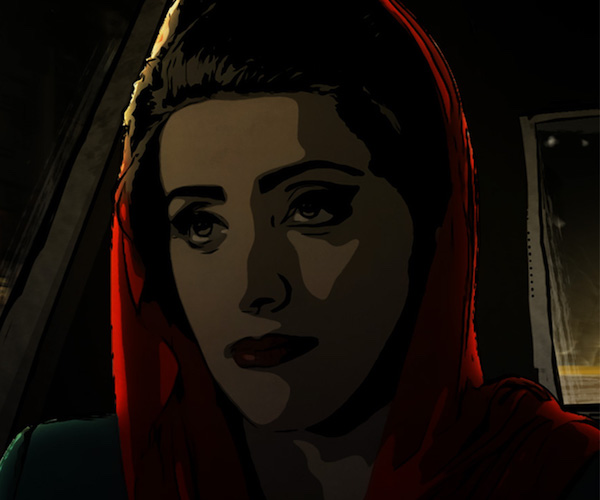Film Review: “Tehran Taboo” — Mesmerizing Animation
Tehran Taboo –- which never would have been allowed to be filmed in its title city — is technically accomplished in its often gorgeous visuals and its textured sound design.
Tehran Taboo, Directed and co-written by Ali Soozandeh. Playing at the Museum of Fine Arts, Boston, Feb. 16, 18, 21, 23 & 28. In Farsi with English subtitles.
By Betsy Sherman

A scene from “Tehran Taboo.”
A prostitute drapes her bare thigh over the shoulder of a man who’s seated on the floor. The man is corpulent, with a full beard and a self-satisfied air. A man of authority. A judge, in fact. The woman wraps a white scarf around his neck and pulls, choking him.
Is this a twist in some thriller about the overthrow of power?
Nah, it’s just what gets him off. The couple’s ritual is one of the jolts in Tehran Taboo, the debut feature of Ali Soozandeh, an Iranian expatriate who has built a career in Germany after leaving home in 1995, at the age of 25. For his exposé of the hidden life of the capital of the Islamic Republic, he has used animation, specifically the rotoscope process in which actors are filmed in front of a green screen and then transformed for the screen.
Tehran Taboo — which never would have been allowed to be filmed in its title city—is technically accomplished in its often gorgeous visuals and its textured sound design. It’s also deliberately bleak, peeking in on lives that are heavily restricted. Attempts at escape are a gamble, and can lead to tragedy.
The prostitute, Pari, is our entry into the story. Appealingly hardboiled, she plies her trade with her mute five-year-old son Elias in tow. In a flashback, we find out she hasn’t lived like this for long. She’s been trying to get a divorce from her jailed junkie husband. But women have no power in the divorce process. After repeated pleas to the aforementioned judge to move forward her decree, she has agreed to become his mistress. After that push, she fell into the street life.
The judge gets her an apartment in a high-rise, and the movie gains a bird’s eye view of the metropolis. The canvas widens to include Pari’s neighbors and the taboos they either indulge in or resist. A young musician, Babak, takes us into a world of parties where the transgressions go far beyond women taking off their headscarves. In a society in which unmarried men and women can’t hold hands in public, drugs, (forbidden) alcohol and sex can be gotten.
Babak longs for creative freedom in his art (his CD can’t be released because it doesn’t adhere to “Islamic values”), but an overriding concern in the film is the state’s tyranny over women’s bodies. Sara, a sweet young woman who’s dutiful to her husband and his family, yet would rather work outside the home as a teacher than bear children, is a link to the issue of illegal abortion. Medical matters are crucial as well to Donya, who, after an ecstasy-fueled hook-up with Babak at a party, needs to get surgery to “restore” her virginity (yes, this is a real racket) before her impending wedding. Without the signed parental consent required by a legit gynecologist, she and Babak have to come up with an exorbitant fee for a shady doctor.
Lurking at the periphery, and sometimes at center stage, are agents of the morality police, who can pick anyone up for a perceived transgression, which could be something as innocuous as a nudie magazine. Surveying the scene in Big Brother fashion are portraits of the nation’s supreme leaders, one long gone (Ayatollah Ruhollah Khomeini), one still in power (Ayatollah Ali Khamenei).
Even the stodgy elderly are turned into outlaws of a sort. Sara’s diabetic father-in-law desires candy and finds a way to get it—not a crime, but his watching a scantily-clad female dancer via an illegal satellite dish is. The film’s message here seems to be, give a person the freedom to do themselves damage, if they wish.
If Tehran Taboo presents a series of shocks, its shock absorber is the silent child Elias. His big brown eyes take in the panorama of hypocrisy, bribery, blackmail and lies. His response, and his only pleasure, is to make red water balloons from his mother’s stash of strawberry condoms and drop them from the roof onto passers-by.
The animation is top-notch, with mesmerizing pools of color that shift between cooler and warmer palettes, urban grit contrasting with a refreshing drive into the misty countryside. The visuals are sometimes overlaid with reflections and the occasional solar flare. The sound design has depth as well. Babak’s synthesized music melds city noises in with his accordion playing.
The movie’s intertwining stories are engrossing, with Pari the standout character. Soozandeh said in an interview that although there has been great Iranian cinema in recent decades, what has been missing is the direct address of sexuality and social taboos. It’s true that a lot of the appeal of Iranian cinema (like Eastern European cinema of the communist era) is in its use of subtext. Tehran Taboo, having been made a continent away, is certainly frank, but it’s a bit a cold, and it pushes one storyline to a violent extreme—possibly just because it can. It does, however, forcefully indict a state built on fear, a state itself afraid of granting its people any degree of freedom and self-determination.
Betsy Sherman has written about movies, old and new, for The Boston Globe, The Boston Phoenix, and The Improper Bostonian, among others. She holds a degree in archives management from Simmons Graduate School of Library and Information Science. When she grows up, she wants to be Barbara Stanwyck.
